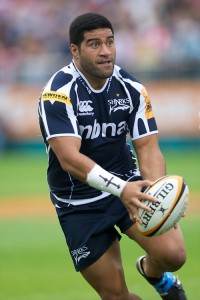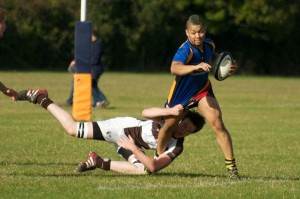I would like to recommend a different style of strength and power training in the gym that will allow rugby players to better transfer their muscle, strength, and power to the pitch.
It has been standard practice to follow a blend of power lifting, weight lifting, strongman and bodybuilding methodologies in order to build or strength, power and mass for rugby.
However, I want to bring attention to the fact that the protocols borrowed from these sports are not ideal for rugby conditioning.
Making alterations to your programme will get you better results that will bridge the gap from the weight room to the field.
The main problem with traditional strength and conditioning protocols is that they train fitness qualities in order of rate of force development and strength/force output requirement, so speed and power movements typically go first, then strength movements, then higher rep hypertrophy work, and then the conditioning exercises come last.
While there is a time and a place for this type of training, rugby players need to alter this routine to get the best results.
High Velocity movements, power movements, and maximum strength movements should be done first in a workout with full or near full recovery to develop the absolute maximum.
If you want to develop speed, agility and quickness to the highest levels, then you should perform these movements in an unfatigued state.
In general (with are some exceptions that I will mention later), if something is important, you should be doing it first in a session and more frequently than other things that you wish to maintain.
In a match, a rugby player will sprint, stop, cut, side step, chase down a runner, scrummage, maul, ruck and jump in a fatigued state.
It makes sense to train speed, power and strength with long rest periods to allow for those qualities to be developed fully.
You should also train strength, power, and speed in a fatigued state, so you can use a higher percentage of your strength, power and speed under fatigue, come game time.
The situations and training methods that break the traditional rule of high velocity, high strength and central nervous system-intensive movements going first are as follows:
1. Contrast Training, and Post Activation Potentiation Training
Contrast or PAP training requires that you perform either a high speed movement followed by a heavy movement or vice versa, using similar motor patterns and the same muscle groups.
Doing this helps you transfer the excitation from the first movement into the second. E.g. you could perform jumps or sprints before a squat or deadlift set in hopes of carrying over your efficient rate of force development into the squat or deadlift.
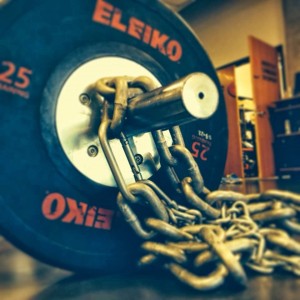
• Front Squats x 3-5 sets of 3-5 reps, follow each of these sets with a 15 to 20 meter sprint – rest around 3-4 minutes between each set.
If you want to encourage a blend of endurance, as well as strength and power, either reduce the rest period or work towards increasing your reps/distances in one of the exercises in the pairing.
For example, increase you bench press or squats to 8-10 reps per set before going into the plyo-presses and 20 meter sprint.
The opposite also works well, i.e. performing more explosive repetitions or increasing your running distance will give you a conditioning effect.
2. Overwarm Work
This is what I use for myself and what I prefer for players and lifters I work with.
Instead of trying to go to a heavy set of 1 to 5 reps trying PR every time, take your typical set/rep scheme for the big lifts (snatch, clean, squat, deadlift, bench, rows) 5×8, 5×5, 3×3, or something similar.
This way you hit the same weight for a number of sets. I find performing these sets with the shortest rest periods that I can manage whilst trying to accelerate in the concentric phase leads to good results.
After that, work up to a heavy set of 1 to 5 – something that you can lift with good speed and form is challenging.
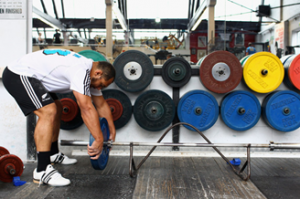 By doing this, you get into the groove of the movement, you get a good warm up (hence overwarm work) and it still allows you to hit something heavy and gain strength. Also, in your fatigued state you’re practicing being strong, aggressive and fast under fatigue, which is similar if not identical to the demands of a rugby game.
By doing this, you get into the groove of the movement, you get a good warm up (hence overwarm work) and it still allows you to hit something heavy and gain strength. Also, in your fatigued state you’re practicing being strong, aggressive and fast under fatigue, which is similar if not identical to the demands of a rugby game.
The benefits of this style of training are twofold: (1) Research has been shown that 70% is the preferred percentage of many high level Olympic weightlifters (FN3) and that 70% is also where peak power is produced in a hang clean. (FN4)
This means that instead of focusing on lots of work in the 85%+ range you can really hammer the 70% loads in your movements, which is where technique and speed can be perfected, but the load is heavy enough to carry over to strength as well.
An example of this training for bench, squat and deadlifts is as follows:
Squat : 70% x 5 sets x 5 reps, followed by 80xsingle, double or triple
Bench Press: 70% x 4 sets x 8 reps, followed by 80%x3 to 5 reps
Deadlift: 75% x3 sets x 3 reps, 85%x1 -3 reps, 90%x 1-3 reps
And similarly for the Olympic lifts, with slightly lower reps due to the higher skill requirement of the movement.
Hang Snatch: 70% x 5 sets x 3 reps, 90×3-5 singles
Clean and Push Jerk: 70% x5 sets x 2 reps, 90% x 3-5 single
For the two lower body movements less volume is used because of the increased demand placed on the body.
If you find yourself using heavier weights for the first sets and reps and more weight for your overwarm work, or you find that the base sets (the multiple sets of 3-5) are easier, and the weight you work up to for the overwarm work is also easier and faster, you know you’ve progressed.
This is a much better way of training year round without taxing yourself so much with max effort attempts every week.
3. Strength/Power Endurance
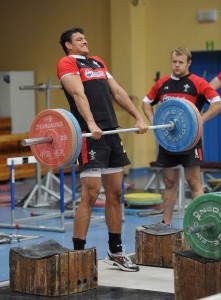 One of the best tools for conditioning is pairing a strength movement for moderate to high repetitions with a specific high speed/power movement.
One of the best tools for conditioning is pairing a strength movement for moderate to high repetitions with a specific high speed/power movement.
Sergey Litvinov, a famous hammer thrower, used to take 400 pounds, front squat it 8 times, and then sprint 400 meters at around ¾ pace, rest and in a few minutes do it again.
Now that is one of the most specific things you could do in a gym setting for rugby. The trick is to combine a strength or power movement (the right answer is squats, deadlifts, or another full body movement), perform a high speed movement afterwards with no rest (e.g. jumps, tackle bag hits, sprints, sled drags), and work towards using shorter and shorter rest periods between sets.
This could be related to having to perform grunt work like rucking, mauling, tackling and then having to get up and break off at speed to the next breakdown, tackle, or carry, or breaking through a glut of defenders and then pinning your ears back to get over the try line.
This method easily falls under contrast training and PAP training, however it’s a distinct variation attacking strength endurance and power endurance, it deserves mentioning on its own.
An example for a normal gym setting would be.
• Squat or Front Squat x a challenging load for 8 to 10 reps (there should be no doubt if you were fresh you could get 10-12 reps with this load and as a rule of thumb use a weight that would allow for another 3-4 reps if you were to go to failure).
• Immediately afterwards, get onto a bike, treadmill, or rowing machine and sprint all out for 15 to 20 seconds.
• Repeat this 3 times and the perhaps call it a day; this is probably the only thing you’d do for leg day if you did it properly.
If you’re going to do this, do it once a week or maybe twice per week in the off-season. If you insist on trying it in season, do it early in the week.
This method was coined Litivinov’s or litvi sprints by the famous thrower and Coach Dan John.
His article will give you even more ideas for this training method.
4.Conditioning Circuits
If you’re in the off season or wish to add a conditioning component to your workouts, I suggest performing a Metcon circuit. Here is one good option:
• Upper Body Push – Press Ups, Jammer Machine, Handstand Press Ups, Push Press
• Upper Body Pulls – Chins, and Row variations with various grips and implements
• Upper Body Power – Medicine ball Slams, Sledge Hammer Swings, plyo press ups.
• Full Body Strength or Power – Clean & Snatch variations (power, high pull or pull), Speed Dront or Back Squats.
1. Yetter, M., & Moir, G. L. (2008). The acute effects of heavy back and front squats on speed during forty-meter sprint trials. The Journal of Strength & Conditioning Research, 22(1), 159-165. 2. Tsimachidis, C., Patikas, D., Galazoulas, C., Bassa, E., & Kotzamanidis, C. (2013). The post-activation potentiation effect on sprint performance after combined resistance/sprint training in junior basketball players. Journal of sports sciences, 31(10). 3. Zatsiorsky, V. M. (1992). Intensity of Strength Training: Facts and Theory Russian and Eastern European Approach. National Strength and Conditioning Association Journal, 14, 40-40. 4. Kawamori, N., Crum, A. J., Blumert, P. A., Kulik, J. R., Childers, J. T., Wood, J. A., & Haff, G. G. (2005). Influence of different relative intensities on power output during the hang power clean: identification of the optimal load. The Journal of Strength & Conditioning Research, 19(3), 698-708.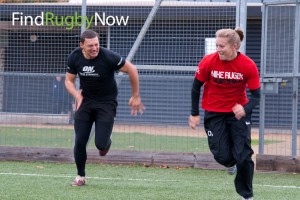








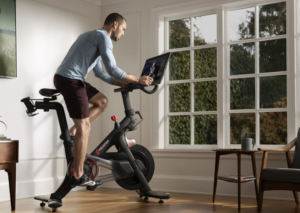 When most people hear the word “Peloton” they think of an expensive black bike with shiny red buttons and that controversial commercial where the husband gifted his wife a Peloton for Christmas.
When most people hear the word “Peloton” they think of an expensive black bike with shiny red buttons and that controversial commercial where the husband gifted his wife a Peloton for Christmas.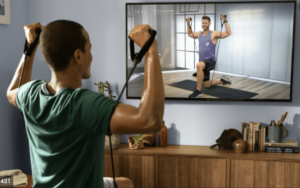 If the app interests you, Peloton is currently offering a 30 day FREE TRIAL, so why not give it a try? Check it out
If the app interests you, Peloton is currently offering a 30 day FREE TRIAL, so why not give it a try? Check it out 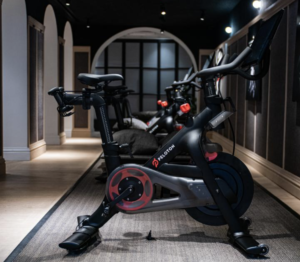
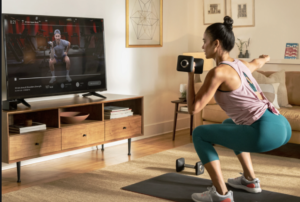
 This article would not be complete, however, if we did not acknowledge some of the delivery issues that have been plaguing Peloton over the last year. Most of the delivery issues seem to affect U.S. deliveries, however, the UK deliveries have been affected as well.
This article would not be complete, however, if we did not acknowledge some of the delivery issues that have been plaguing Peloton over the last year. Most of the delivery issues seem to affect U.S. deliveries, however, the UK deliveries have been affected as well.





